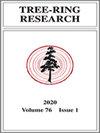草本年轮作为植物对干扰反应标记的效用&以乌耳草草原常见乳草属植物的根系为例
IF 1.1
4区 农林科学
Q3 FORESTRY
引用次数: 5
摘要
摘要草本植物年表是对多年生草本植物根冠过渡带的年生长环的研究,主要致力于寻找生长增量与年气候之间的相关性。使用生长环作为植物对周期性干扰等更多生态现象的生长反应标记的潜力仍然很大程度上尚未开发。通过监测来自美国牛脂草草原系统的64个常见乳草物种(Asclepias viridis)的2016年生长增量,我们研究了植物对早季芽去除和相邻疏伐因子处理的反应。这些处理模拟了草食性、放牧和休眠季节的火灾,每一种都会对植物生长产生不同的影响。邻区变薄对研究的影响最大,适度增加了环的宽度。相反,移除嫩芽后,环宽度适度减小。个体年龄对环宽度有负面影响。这些结果首次证明了草本年轮对资源的突然改善以及地上生物量的显著损失敏感。草本植物年表可用于未来监测干扰对植物生长影响的研究,增加我们对这些现象及其对草原组成的总体影响的了解。本文章由计算机程序翻译,如有差异,请以英文原文为准。
UTILITY OF HERBACEOUS ANNUAL RINGS AS MARKERS OF PLANT RESPONSE TO DISTURBANCE: A CASE STUDY USING ROOTS OF A COMMON MILKWEED SPECIES OF THE US TALLGRASS PRAIRIE
ABSTRACT Herb-chronology, the study of annual growth rings in the root to shoot transitional zone of perennial forbs, involves efforts mostly devoted to finding correlations between growth increment and annual climate. The potential of using growth rings as markers of plant growth response to more ecological phenomena such as periodic disturbance still remains mostly untapped. By monitoring the 2016 growth increment of 64 individuals of a common milkweed species (Asclepias viridis) from the US tallgrass prairie system we investigate plant response to factorial treatments of early season shoot removal and neighbor thinning. These treatments simulate bouts of herbivory, grazing, and dormant-season fire, each of which should have differential effects on plant growth. Neighbor thinning had the strongest effects of the study, moderately increasing ring widths. Conversely, ring widths were moderately decreased by shoot removal. Individual age had negative effects on ring width. These results are the first evidence of herbaceous annual ring sensitivity to sudden amelioration of resources as well as a significant loss of aboveground biomass. Herb-chronology could be useful in future studies monitoring the effects of disturbance on plant growth, increasing our understanding of these phenomena and their overall effect on grassland composition.
求助全文
通过发布文献求助,成功后即可免费获取论文全文。
去求助
来源期刊

Tree-Ring Research
农林科学-林学
CiteScore
2.40
自引率
12.50%
发文量
15
审稿时长
>36 weeks
期刊介绍:
Tree-Ring Research (TRR) is devoted to papers dealing with the growth rings of trees and the applications of tree-ring research in a wide variety of fields, including but not limited to archaeology, geology, ecology, hydrology, climatology, forestry, and botany. Papers involving research results, new techniques of data acquisition or analysis, and regional or subject-oriented reviews or syntheses are considered for publication.
Scientific papers usually fall into two main categories. Articles should not exceed 5000 words, or approximately 20 double-spaced typewritten pages, including tables, references, and an abstract of 200 words or fewer. All manuscripts submitted as Articles are reviewed by at least two referees. Research Reports, which are usually reviewed by at least one outside referee, should not exceed 1500 words or include more than two figures. Research Reports address technical developments, describe well-documented but preliminary research results, or present findings for which the Article format is not appropriate. Book or monograph Reviews of 500 words or less are also considered. Other categories of papers are occasionally published. All papers are published only in English. Abstracts of the Articles or Reports may be printed in other languages if supplied by the author(s) with English translations.
 求助内容:
求助内容: 应助结果提醒方式:
应助结果提醒方式:


